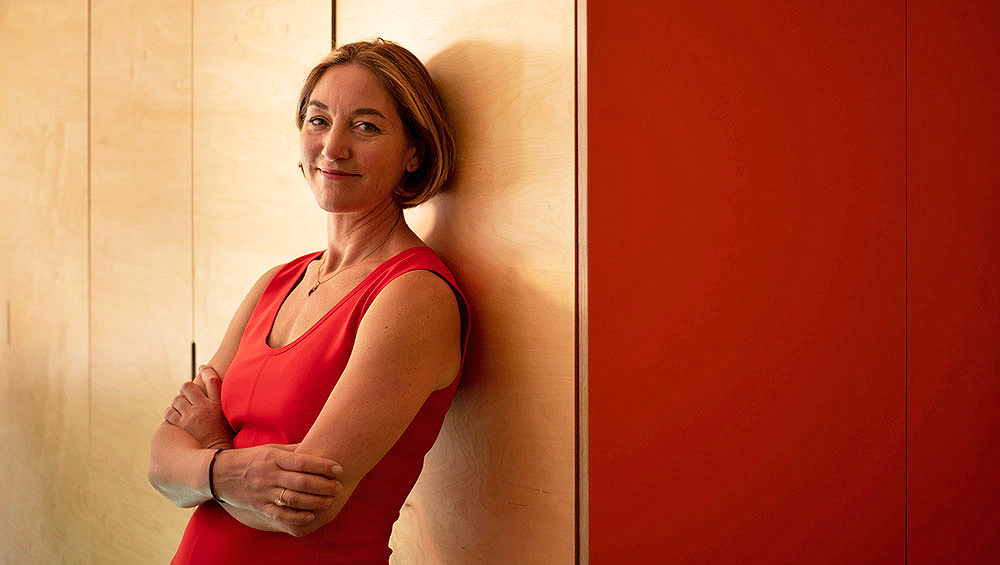
Sadie Morgan. Photo: Jim Stephenson.
by VERONICA SIMPSON
Sadie Morgan (b1969, UK) is one of three founding partners of De Rijke Marsh Morgan (dRMM), a Stirling-prize-winning practice based in London, which has made a name for itself for its beautiful and sustainable buildings and for its commitment to working closely with the communities for whom these buildings are intended. While the words “participatory” and “co-design” have become hugely fashionable in contemporary architecture, what many practices are discovering or trying to foreground anew, this practice has been doing since it was set up in 1995.
That is true of the elegant Maggie’s Centre in Oldham, a timber structure with an elliptical core penetrated by a large tree, and of Hastings Pier, for which the practice won the 2017 Stirling Prize, despite it being, in effect, a public space left more or less empty of structures so that the townspeople can better define how it is used.
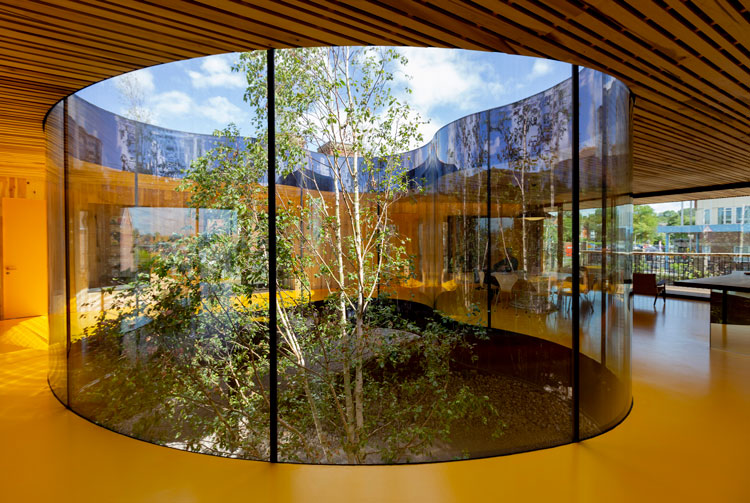
Maggie’s Centre in Oldham, central window. Photo: AdeRijke, courtesy dRMM.
Morgan’s name has really come to the fore in the last seven years, as a passionate advocate for joined-up thinking, since becoming the Architectural Association’s youngest ever president, in 2013. It is Morgan’s role as advocate for expanding conversations beyond the usual built-environment silos that makes this practice so significant, at a time when buildings designed for their positive social impacts (rather than enriching the bank balances of developers) are needed more than ever. It is also that thinking – supported by Morgan’s two co-founders and co-directors Alex de Rijke and Philip Marsh - that has allowed the practice to champion gender equality in a profession that still struggles to demonstrate equal pay or treatment, or to promote and mentor young employees.
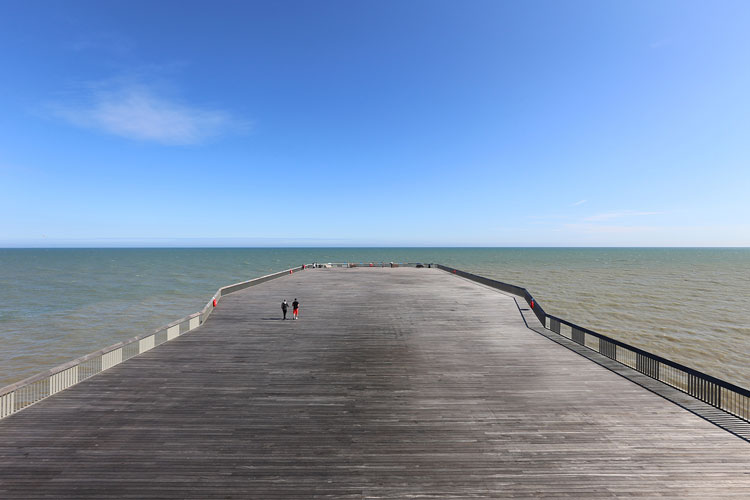
Hastings Pier. Photo: J Robertshaw, courtesy dRMM.
Morgan, who studied architecture at the Royal College of Art, now divides her time between the practice and ensuring greater coherence in wider built-environment initiatives. She is a board member of the UK government’s National Infrastructure Commission (NIC) and is one of the London mayor’s design advocates for the Greater London Authority. As chair of the design panel for HS2, the high-speed rail link between London and Birmingham, Morgan is championing great-looking tunnels, viaducts and bridges and enhanced public space. She has also set up the Quality of Life Foundation, partly funded by leading UK developers, to establish better guidelines for creating optimal homes and neighbourhoods for all.
Morgan believes her commitment to community was formed early, thanks to her upbringing in a multi-generational Sevenoaks commune founded by her grandfather. Her public role – and the challenges of public speaking – came less naturally, she says, but was something she felt she had to practice in order to encourage more young women to step up and be visible in the male-dominated built environment professions. Her efforts have not gone unnoticed: in 2014, she was shortlisted for the Architects’ Journal Women in Architecture award; in 2015, she received a Confederation of British Industry First Women award; and, in 2020, she was awarded an Order of the British Empire (OBE) for services to the advocacy of design in the built environment.
Morgan spoke to Studio International by phone in late 2020.
Veronica Simpson: You have said that when the three founding partners of De Rijke Marsh Morgan met, while you were all students at Kingston University, you felt united in a shared vision and purpose. Can you summarise what that vision and purpose was?
Sadie Morgan: At the time, we just wanted to make things better. There was a big recession (late-80s/early-90s), things were scarce, and it felt like a moment in time where things needed a bit of adjusting. There was a sense that, together, we should be building practices that were more cohesive, participatory, less driven by a star architect, much more about a team and collaboration, with a drive to improve people’s lives through the built environment. One of our principles was to create socially useful architecture, but not by reinventing the wheel, more in the spirit of using what we have.
Most of our work at that really early stage involved going to B&Q and improvising. A lot of the materials we used in different ways: for example, we’d use roofing polycarbonate as a wall. Then we did Sliding House, which is still one of the most iconic projects we have done, and brings joy to everyone who watches it in action.
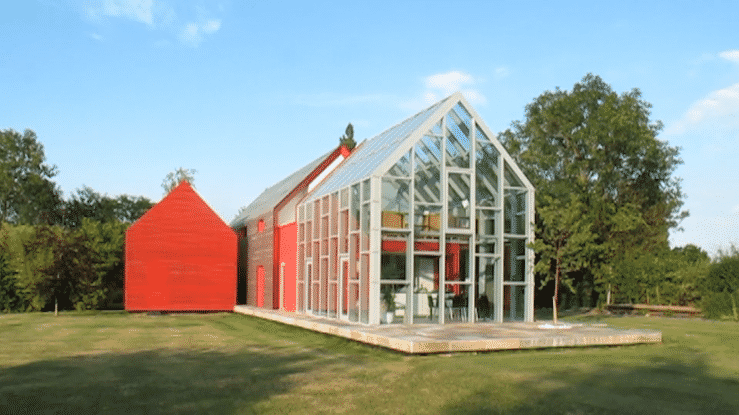
Sliding House, Suffolk, UK. 2009. Image courtesy dRMM.
It’s a house that moves on train tracks: the roof and walls move as one to reveal different aspects, so it changes over seasons. We built it very cheaply: it was £360,000 or something. That was because most of the materials were taken off the shelf and repurposed in different ways. We were very focused on thinking laterally about problems. Sliding House happened because the client said he wanted to live in a glass house. We said: you can’t do that.
VS: But you gave him the next best thing.
SM: In the morning, you open up the house and the sun heats it up and then you cover it with a jacket to keep it warm. And you can moderate heat and the light that you get, as well as enjoying the opportunity to open your house up to the sky. It’s such an extraordinary project, but the grounding principle is that it’s very sustainable. It’s so energy efficient that it sells its energy back to the grid. That project, from early on, encompassed the work we like to do, a lateral-thinking exercise: how do you solve a problem in a different way, in a way that brings joy, but is also pragmatic?
VS: I’ve heard that it’s the all-time favourite house of Grand Designs presenter Kevin McCloud.
SM: We were newbies on the block and it captured the imagination. It’s a bit like (Stirling Prize-winning) Hastings Pier. Hastings Pier won because it was about the community and collaboration and the architect as curator rather than designer.
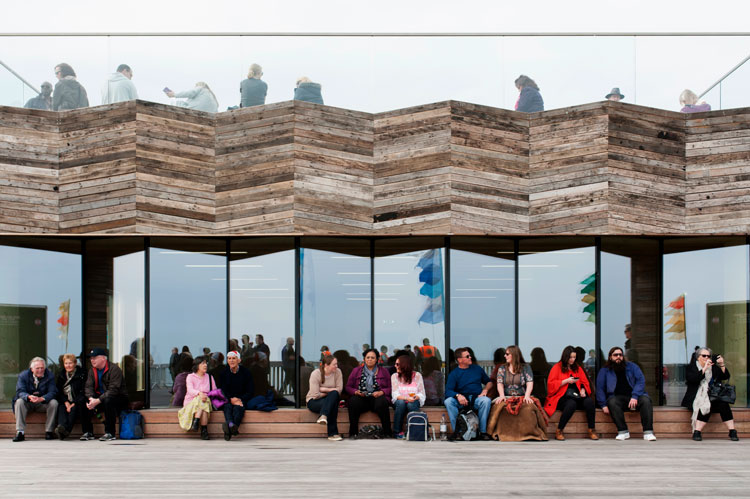
Hastings Pier. Photo: J Robertshaw, courtesy dRMM.
VS: How do you feel that participatory, improvisatory spirit you started with chimes with the current mood in architecture?
SM: There are collectives popping up all over the place. We are coming back to a time where we’re all beginning to understand that we don’t have the answers and no one person is intelligent, skilful or experienced enough to come up with the silver bullet - which actually doesn’t exist. There’s a sense that we need each other in a way that perhaps in the past we felt we didn’t: we piled all our hopes or dreams on one or two or three people. Architects are inherently egotistical. In the past, they’ve been taught to be a little bit like that. It’s an explosive combination. I think the way architects are now taught is again much more collaborative. Schools of architecture are promoting much more the need to think about things together. Not just within your own discipline but interdisciplinary, we need to talk to landscape designers, engineers. The work I’ve done with the NIC is to put these design principles together to show some leadership around how we encourage not just architects and designers, but everyone in the profession, to think about design as their responsibility.
VS: Do you feel that your early vision and purpose and those values have changed over time?
SM: If anything, it’s just got stronger. And it’s so important to encourage the next generation, who are generating their own agendas and pushing things forward. What we have always tried to do is encourage that level of conversation and debate within the practice. There are two young women in our practice who were fundamental in starting the Architects Climate Action Network. I’m proud that we have allowed that to evolve and happen within the framework of our practice. It has been supported and made possible by giving time to allow these things to pop up. The dynamic organisation that we had as a young practice still feels very much the same, which is very exciting.
After 25 years of practice, we took a look at ourselves, and we asked ourselves: are our principles and ethos still the same? Yes, they are. We still make socially responsible architecture. We were the first people to build in cross-laminated timber in the UK. We are consistently pushing the climate agenda. We are radical makers. We have always tried to take things on and do things in different ways. In order to keep that frisson and innovation we need to enable the bubbling of ideas to continue to happen in the practice. Now, 25 years on, we can do that within a framework of real experience, because we have built many more buildings, had many more clients. We’ve also consolidated a lot of the things that we know we do well. There’s a fabulous mix now: we have the experience and longevity of those running a practice, which brings a certain amount of credibility and kudos to what we do, and we still have the energy of a younger generation who are fighting and critiquing. It’s not the founding directors that lead the critique. When we have design crits, it’s usually the Part 1 students who are making the change, pointing out where we could do better. It’s very non-hierarchical. Everyone feels they can challenge and everybody’s voice is as relevant as anybody else’s.
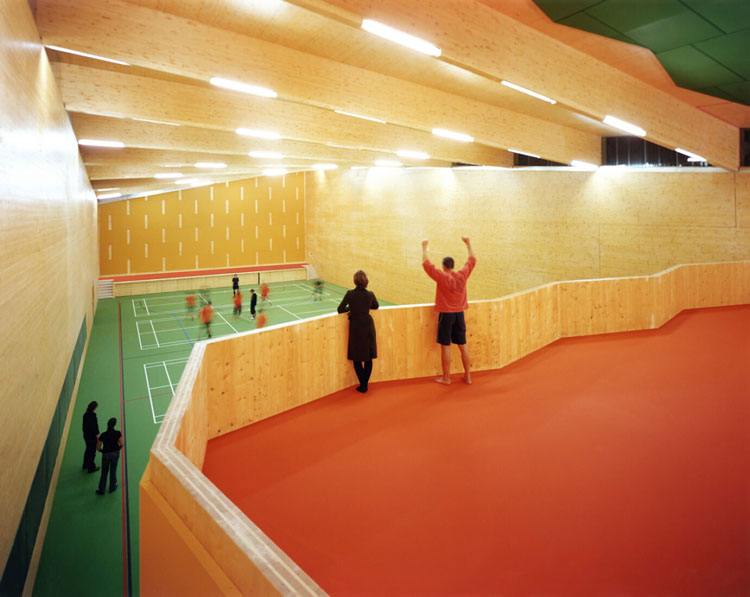
Kingsdale school, sports hall, London borough of Southwark. Photo: F Karim, courtesy dRMM.
VS: What would you say were the most significant projects in shaping the evolution of your practice – not just the ones that have been most lauded or awarded, but those that provided the greatest learning or growth?
SM: Sometimes you don’t decide what those are. When we were working on Kingsdale school, in the London borough of Southwark, that was an incredible period in our lives. It was such an extraordinary bringing together of people who wanted to actively improve something - improving results, students’ pride and turning around a sinking school into one of the best performing schools in the borough. The process did that. It’s when you’re part of a community that architecture becomes more than the physical. It’s an ingredient in a much more complex organism.
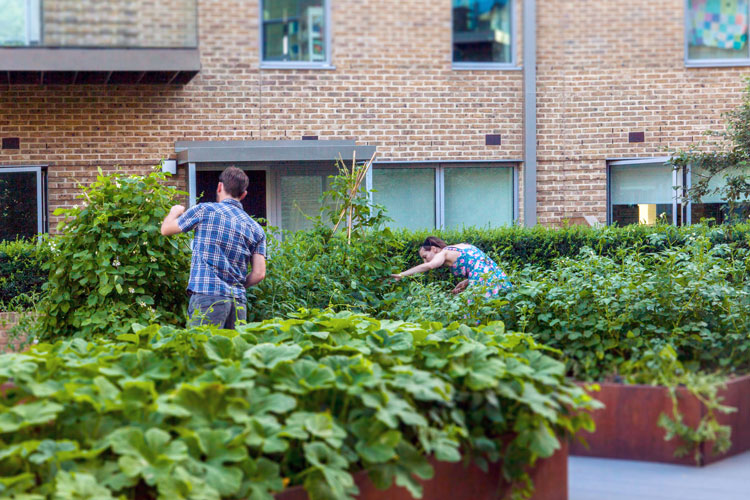
Trafalgar Place, south London. Image courtesy dRMM.
Some projects have been challenging, more than others. Trafalgar Place (a housing development in south London), which was shortlisted for the Stirling Prize, was controversial at first, with the community being displaced for that redevelopment. We were part of the first phase. There was a lot of trust that had to be brought back. That, for us, was an incredibly positive outcome, in a situation that we turned around because we told the truth and tried really hard not to over-egg expectations, and to talk about what was possible, understand what matters. The community really wanted to keep their mature trees. We designed the whole of the scheme to make sure we retained the most mature trees. It’s made a massive difference to the public realm; it is 50% more open to the public than it would have been. We created a thoroughfare that the existing community now uses all the time. A lot of that was about listening to people. Every project has something about it that enriches your personal journey.
VS: Obviously, we have to mention Hastings Pier, your 2017 Stirling Prize-winner: such a great project, but sadly now cordoned off and unused because the charity that raised the money and momentum to repair it and then run it later went bankrupt.
SM: When it comes to Hastings Pier, the things that embodied the practice are all there. Normally, an architect would just design a beautiful building on the end of the pier. We said: “No, we’re not going to do that.” We did a small visitor/community centre, but the scheme was about building nothing (so that the community could be free to programme that space as it wished) …that’s quite a mature and generous thing to do.
The closure was a real tragedy after all that energy and effort the community put into it. There should be a public enquiry into what went wrong.
VS: In which areas do you feel the practice of architecture today is very different from how it was when you entered the profession, for better or for worse?
SM: I remember in my early career being a judge for the Royal Institute of British Architects and thinking: “How can anyone build this irresponsibility in terms of carbon emissions and the general long-term sustainability of what they’re doing?” Nowadays, there’s much less of that, along with this whole flip of big corporations wanting to be seen to be responsible, therefore not encouraging the statement glass towers that just are fundamentally wrong. We have to adapt, we have to change if we want to stay in business. We hope it’s coming from a sense of largesse. I still think as a profession we need to connect better, and talk about things in ways that the general public understands. We really do need to talk to communities, the wider population more than we do. We shouldn’t just listen and move on. We curate ideas in a way that is much more participatory. I think we’re getting the message across, but we’re still a bit slow. We are painfully behind on diversity and inclusion. And there’s no excuse.
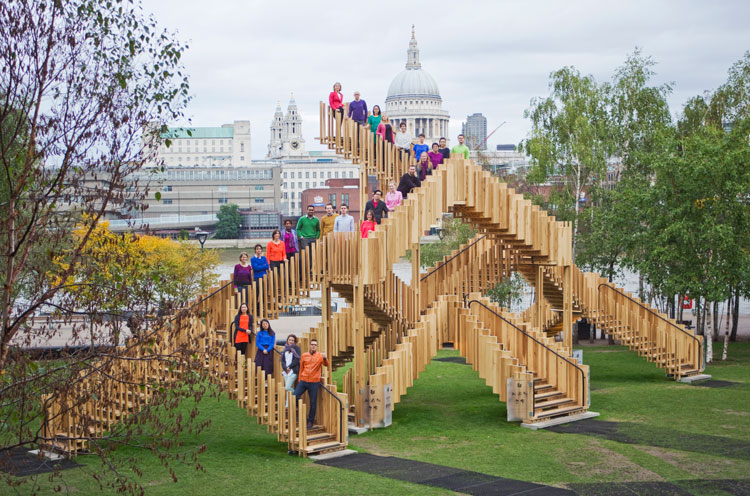
Endless stair. Photo: AdeRijke, courtesy dRMM.
VS: You have talked about the importance of joy in the company culture. How do you ensure that joy flourishes, in a profession where incredibly long hours and burnout are more the norm?
SM: The first thing to do is give people some space. It’s a tough profession. Just before lockdown, we were considering going to a 36- hour week. We genuinely believe people are more productive if they’re happy and have a work-life balance. We’ve always been very aware of the need for a culture that is supportive, that allows people to take time to do the things that they want. We have always been very encouraging of extracurricular activity. In any profession, you can get so engrossed in what you’re doing that you forget there’s a world out there. Joy comes from fulfilment. If you feel supported and encouraged, it is much easier to be happy and joyful in what you do. I think if you are in a good place and feeling all those things, that comes out in what you do. And because that’s the kind of practice we are, we tend to attract people who feel the same.
VS: How has the pandemic impacted on your working practice and company culture?
SM: Everything we are doing is driven by what the team wants to do. At the moment, every conversation we’re having is based on doing a survey, asking everyone what it is they want, with an understanding of how important our studio culture is. If you’re a practice like ours, the frisson and the team are so important. At the moment, the guidelines are clear. But we want to get to a place where we take the best out of this awful situation, which means more remote working from home. We have 21 nationalities in our office. Throughout lockdown, we had a number of people not even in the UK and that’s because they wanted to be close to family. Of course, that’s absolutely essential. But you have to balance running a business and making sure the work is done, by people who feel safe, but also connected. We’re definitely going to be moving to a different working model, one that has more remote working, but that brings people together at those moments when you need to be together.
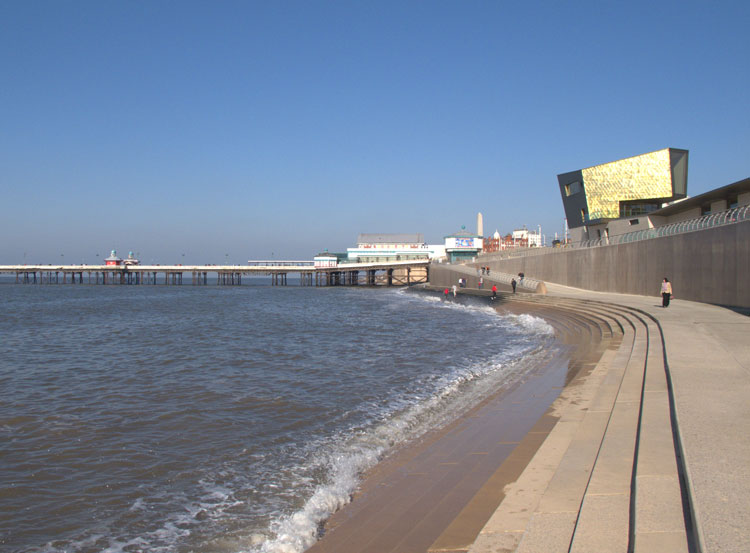
Tower of Love, Blackpool. Photo: AdeRijke, courtesy dRMM.
We did a piece of research through the Quality of Life Foundation, alarmed by reports that the mental health of lots of young people is being negatively affected by lockdown. It’s all very well at our age, but we need to continue to mentor and teach and impart knowledge and there’s so much that doesn’t happen across a Zoom call. The Part 1 and Part 2 students come in and learn so much. They are the ones who are suffering. We have to make sure that that generation doesn’t get lost. When I was at the Royal College, I didn’t learn anything from my tutors – it was all from my peers.
VS: Your focus seems now to be on connecting the best of architectural skills and thinking into areas of society where it is needed most – infrastructure and procurement, rather than designing buildings. When and why did you feel that your energies might be best spent on these crucial, sector-wide initiatives?
SM: In terms of my career, I took on presidency of the Architectural Association and that was the beginning of a close scrutiny of being in a world where I thought we as architects are just talking to ourselves. And, of course, we’re going to agree how terrible the world is, but unless we do something about it, that culture is never going to change. I chose (to work on) HS2. Then I sat on the NIC board and realised that there are very few creative thinkers. I’m not saying that economists aren’t creative thinkers, but they are very linear. Very few people like me, with my background, sit at the table where these big policy decisions are being made. They were surprisingly receptive: a lot of people around that table wanted to hear what I had to say. There’s no surprise that most people want to improve our built environment, our lives and our quality of lives. Everyone does it in the way they think is best. When you say we need to design our infrastructure, transport planners are not the people to be designing that. But it’s through good design that we can embed infrastructure that is more reflective of the people who live there, their identity and diversity, because these are the things that architects think about. They may not be the things that an engineer thinks about. We have published the first ever design principles for design infrastructure – incorporating climate, people, place and value. We have got the Institution of Civil Engineers on board, and it has done a massive piece of research about that to ask all its engineers about good design and how we might do it better.
As a profession, we have not done a very good job of promoting ourselves and what we do. There is so much we can do, but when we talk about our buildings, it’s about the kind of brick or the composition. It’s not about the wider impact. That’s the bigger story. We’ve got to be much better at being part of a bigger team, being at the table when these decisions are being taken. When you are deciding whether or not you put a piece of transport infrastructure in the north-west, let’s not base that on speed and time and cost, but on climate, people, place and value.
VS: In this new, more thoughtful, era that we hope might emerge, post-pandemic, where genuine social and environmental responsibility becomes a given, what role do you feel beauty plays in the mix?
SM: Beauty has become a loaded term because of its links to a certain patrician attitude to art and architecture that too often becomes shorthand for “classical”. But I would agree with the need to make and appreciate things that are beautiful, if you mean bringing more wonder into our lives, by which I mean a sense of delight, a distinct identity and a measure of playfulness. In that sense, beauty has the power to lift our spirits and improve our wellbeing, and I would wholly support it - not as the answer to everything, but part of the answer to the complex web of what can improve our quality of life.